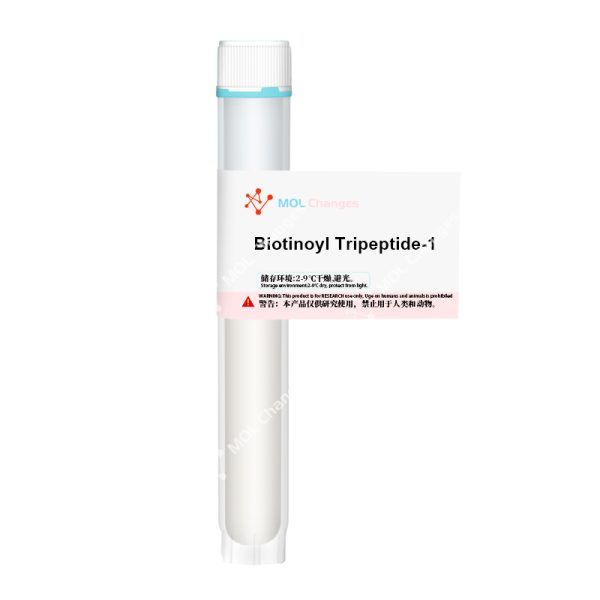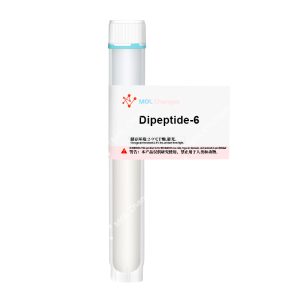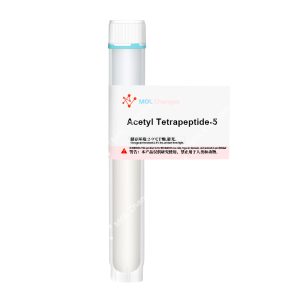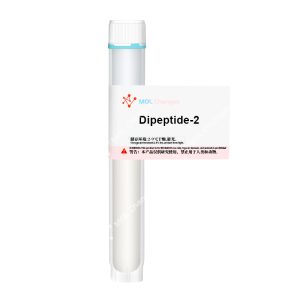Biotinoyl Tripeptide-1 (other name: Bio-GHK / Biotin-GHK / Biotinyl-Gly-His-Lys / Biotinyl-GHK) is a bioactive peptide formed by covalently linking biotin (vitamin H) to GHK – the glycine-L-histidine-L-lysine tripeptide. This conjugation preserves the core sequence of GHK; theoretically allowing it to retain at least some form of its original biological functions, while introducing the more specific binding capabilities that biotin is capable of.
Sequence
Biotin-Gly-His-Lys-OH
CAS Number
299157-54-3
Molecular Formula
C24H38N8O6S
Molecular Weight
566.7 g/mol
Research Of Biotinoyl Tripeptide-1
The structural core of Biotinoyl Tripeptide-1 itself is this tripeptide GHK. Extensive research has been performed on GHK’s various broad biological activities – tissue repair, anti-inflammation being two prime examples, with anti-aging being the more recently studied aspect.
Biotin as a key coenzyme facilitates the synthesis of keratin (the primary protein found in hair); maintaining hair health is one of its near constant roles. Linking it to the peptide provides a potential additional nutritional support, but the more important factor is biotin’s near perfect affinity for hair follicle cells; improving binding efficiency at these target sites, bioavailability and to a point efficacy [1].
Research indicates the successful retention of GHK’s copper-binding, various antioxidant and anti-glycation activities; targeted delivery being the primary enhancement biotin modification allows. Significant inhibition of acrolein (ACR)-induced Aβ carbonylation (an oxidative damage marker) and reduced formation of said adducts is observed.
Ascorbic acid oxidation catalyzed by the Cu(II)-Aβ complex is also inhibited, lessening all subsequent reactive oxygen species (ROS) generation (again, partial efficacy compared to pure GHK is seen, the occupied C-terminus being a likely factor).
Spectrophotometric analysis (2-(4′-Hydroxyazobenzene) Benzoic Acid/HABA displacement) confirmed high streptavidin binding by Biotinoyl Tripeptide-1 – pure biotin level targeting is maintained.
Biotinoyl Tripeptide-1 is and remains a unique biotinylated peptide, with or without cosmetic applications, to all intents and purposes a novel molecule of great interest to both science and the end user.
Biotinoyl Tripeptide-1 is typically combined with various other anti-hair loss active ingredients; minoxidil, finasteride, different types of plant extracts (saw palmetto being a prime example, salvia miltiorrhiza and ginkgo biloba also being well studied), vitamins (biotin if I recall correctly being the most common, the broader B vitamins), and trace elements like zinc and selenium.
The combination follows a multi-target therapeutic approach – addressing what I believe to be multiple, simultaneous pathophysiological mechanisms of hair loss.
Biotinoyl Tripeptide-1 itself is a multifunctional peptide, the result of some form of molecular engineering. GHK’s inherent regenerative, antioxidant and to a point neuroprotective properties are skillfully combined with biotin’s more specific delivery capabilities.
Commercially in the cosmetics field it has established itself as both an anti-aging and (more recently) hair growth promoting ingredient. The previously mentioned inhibition of amyloid aggregation is pushing research forward; neurodegenerative diseases, Alzheimer’s specifically, are promising future applications.
Deeper and more comprehensive research will only further define Biotinoyl Tripeptide-1’s place in all eventualities of human health and disease.
COA
HPLC
MS









Reviews
There are no reviews yet.